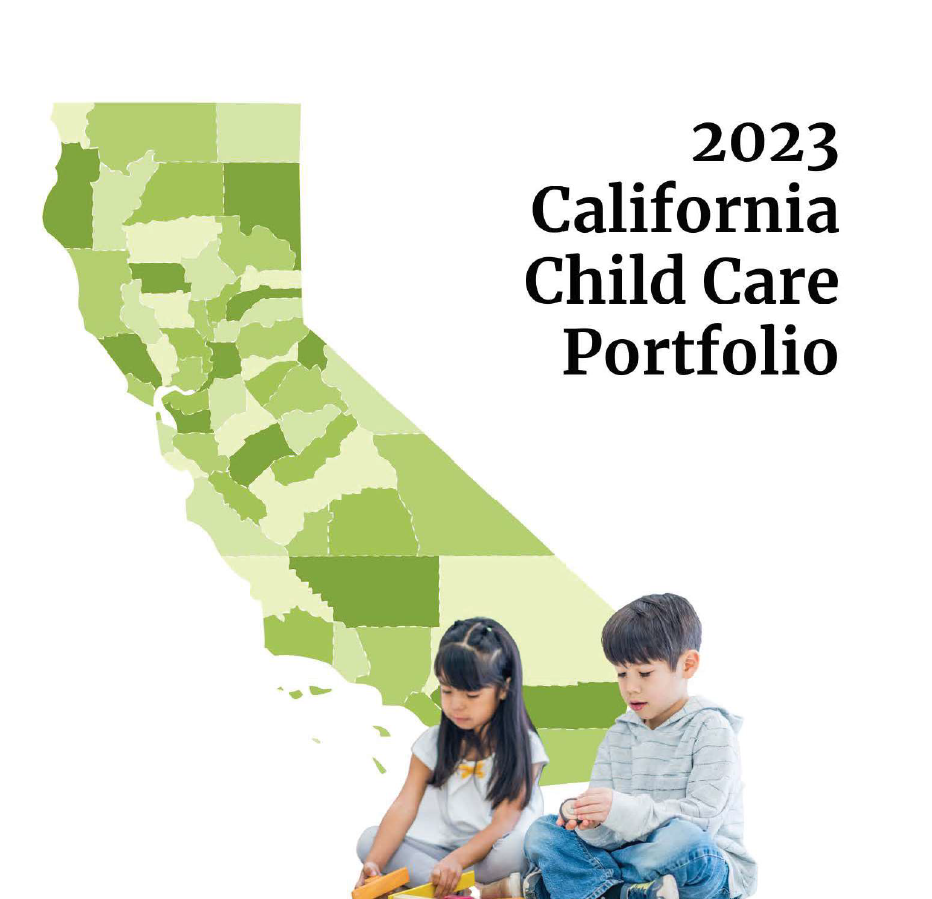Watch the briefing
Since 1997, the California Child Care Resource & Referral Network has produced the biennial California Child Care Portfolio. This presents a unique portrait of child care supply, demand, and cost statewide and county-by-county, as well as information on employment, poverty, and family budgets. The child care data in this report is gathered with the assistance of local child care resource and referral programs. This publication has consistently been relied on by policymakers, business leaders, health care professionals, educators, planning agencies, and child advocates to understand the child care needs of California families.
2023 California Child Care Portfolio
California Data
Understanding the Data
Download slides (including maps and graphs)
For more information, please contact research@rrnetwork.org
For additional data needs, fill out our data request form here
Help us spread the word, toolkit found here
Press Release
THE 2023 CHILD CARE PORTFOLIO IS LIVE!
The California Child Care Resource & Referral Network (R&R Network) is excited to announce the release of our 14th biennial California Child Care Portfolio, which tracks major changes in licensed child care supply, demand, and cost by county and statewide, as well as information on populations, poverty, and family budgets. The 2023 report shows that families continue to struggle to afford and find child care. California must continue to invest in child care to support working families and stabilize the limited supply of child care businesses.
San Francisco, CA — We are proud to present the 14th edition of the California Child Care Portfolio, continuing the R&R Network's commitment to strengthening the child care system in California through research, advocacy and partnership with the statewide Child Care Resource & Referral (CCR&R) system. Data in the Portfolio illustrates the value of real-world child care data collected by CCR&Rs as they listen and understand the needs communicated by families and providers across the state. The 2023 report shows that families struggle to afford and find child care. California must continue to invest in child care to support working families and child care businesses.
“Though the report shows no loss in licensed child care programs across the State, which is likely due to pandemic-related relief funding, licensed care is still only available for 26% of children with working families. Families who do find child care will spend one-quarter of their income on those costs. The Network’s vision is that child care is recognized as a basic, universal public good, much like elementary education or healthcare. Financial instability of child care providers is a threat to this vision, making the outlook of the availability and, thereby, accessibility of child care for all families uncertain. We know that child care is essential for working families, businesses, and for children’s long-term success. We need to do more to protect and build this important resource for California’s economic success.”
-Linda Asato, Executive Director, California Child Care Resource & Referral Network
Key findings from the 2023 Child Care Portfolio include:
Increase in Statewide Licensed Supply: In 2023, there was an increase in California’s licensed child care supply compared to 2021, with a 3% overall increase in child care spaces, including a 1% increase in family child care home spaces and a 3% increase in center spaces.
Family Child Care Supply Turning Point: Family child care spaces increased for the first time after years of steady decline since the 2008 Great Recession. While this growth signals progress, the State remains nearly 100,000 spaces below pre-recession levels of licensed child care supply, underscoring the ongoing need for sustained investment and support for providers.
Center Infant Care Capacity on the Rise: Center infant care capacity is also on the rise, seeing a 14% increase in spaces when compared to 2021—a significant jump that may reflect a broader shift in the child care landscape in response to the expansion of Transitional Kindergarten. The growth of pre-school and Transitional Kindergarten options may have prompted child care centers to adjust their services to serve younger-aged children.
Regional Variation: While licensed child care increased statewide, growth varied by region. When comparing 2021 and 2023 data, the Bay Area saw the largest increase, with a 7% rise in licensed spaces, followed by a slight 1% increase in the Central Valley and Southern California. In contrast, the Northern region saw a 2% decline, underscoring ongoing regional differences.
Policy Recommendations
The increase in licensed child care spaces is likely a result of public investments during the pandemic. To ensure the stability and further growth of our licensed child care programs, we must continue to advocate for fair provider pay, universal child care, and protecting state and federal investments in child care.
Fair Provider Pay
In California, the median cost of child care in a licensed family child care home in 2022 was $1,232 per month for an infant and $969 per month for a preschooler. If a licensed family child care provider cares for three infants and three preschoolers—aligning with licensing ratio regulations—they would earn approximately $6,603 per month in gross income, before accounting for any business expenses. By comparison, the state median income in California in 2023 was $8,697. This means the provider would fall $2,094 short of the state median income. We know that even the state median income often leaves families struggling to meet all of their expenses. As a result, many child care providers operate at a loss, leaving them vulnerable to business closures and struggling to meet their own basic needs.
A key step toward protecting the current supply of licensed child care is minimizing the financial strain on providers who are operating at a loss. One way the state can assist is to reform its subsidized child care reimbursement rate structure to one that reflects the true cost of care. Current reimbursement rates are based on regional market rates, or the price that a consumer is willing to pay, which does not accurately represent the actual costs of providing child care.
It is also critical that child care providers serving subsidized children are paid based on enrollment, not attendance. The overhead costs of running a child care business remain constant regardless of daily attendance, and providers need predictable, stable revenue to plan and sustain their operations. During the pandemic, the state temporarily adopted enrollment-based payments for subsidy providers—contributing toward supporting providers' financial stability, and is why we suspect we did not see a huge loss of licensed facilities in this two year period. This practice should be codified permanently to ensure a stronger, more resilient child care system.
Ensuring All Families Have Access to Affordable Child Care
Ensuring all families have access to affordable child care is crucial to supporting children’s development and parents’ ability to work, pursue an education, and/or participate in training opportunities. As highlighted in the 2023 Child Care Portfolio, child care costs represent a significant share of a family's budget, and only about one in four children with working parents have access to a licensed child care space. Many families seek child care because a parent is employed, looking for work, or enrolled in school or training. A universal child care system would ensure that affordable child care is available to every family who needs or wants it, helping to close this critical gap.
Protecting State and Federal Investments in Child Care
State and federal funding play an enormous role in sustaining and growing child care programs. In 2023, there were 1,835 Head Start/Early Head Start centers in California with about 94,577 funded slots.¹ California also receives federal Child Care and Development Block Grant (CCDBG) and CalWORKs child care. Loss of federal funds into our early childhood system means less availability of child care and more children and families in need of assistance.
Additionally, many child care providers rely on public assistance programs, with 43% of all Early Childhood Education (ECE) providers relying on at least one public assistance program such as Medicaid/Medi-cal or SNAP/CalFresh and roughly 1 in 4 relying on Medicaid for health insurance.² Cuts to these programs deepen their economic insecurity further threatening the stability and well-being of our child care providers.
Summary
Overall, the 2023 Child Care Portfolio shows that licensed child care supply increased, marking a promising shift after years of decline. To sustain this positive trend, we must continue advocating for fair provider pay, universal child care, and the protection of state and federal funding. These changes would impact the entire child care community, including child care providers, families, and the children at the heart of our work.
¹National Head Start Association, California 2023 Head Start and Early Head Start Profile, Early Childhood Learning & Knowledge Center (ECLKC), Office of Head Start, Head Start Center Location Datasets.
²McLean, C., Austin, L.J.E., Powell, A., Jaggi, S., Kim, Y., Knight, J., Muñoz, S., & Schlieber, M. (2024). Early Childhood Workforce Index – 2024. Center for the Study of Child Care Employment, University of California, Berkeley. https://cscce.berkeley.edu/workforce-index-2024/.
Download the 2023 California Child Care Portfolio

View and download the entire 2023 CA Child Care Portfolio.
DownloadCounty Level Data
- » Marin
- » Mariposa
- » Mendocino
- » Merced
- » Modoc
- » Mono
- » Monterey
- » Napa
- » Nevada
- » Orange
- » Placer
- » Plumas
- » Riverside
- » Sacramento
- » San Benito
- » San Bernardino
- » San Diego
- » San Francisco
- » San Joaquin
- » San Luis Obispo
- » San Mateo
- » Santa Barbara
- » Santa Clara
- » Santa Cruz
- » Shasta
- » Sierra
- » Siskiyou
- » Solano
- » Sonoma
- » Stanislaus
- » Sutter
- » Tehama
- » Trinity
- » Tulare
- » Tuolumne
- » Ventura
- » Yolo
- » Yuba
- » Orange
- » Placer
- » Plumas
- » Riverside
- » Sacramento
- » San Benito
- » San Bernardino
- » San Diego
- » San Francisco
- » San Joaquin
- » San Luis Obispo
- » San Mateo
- » Santa Barbara
- » Santa Clara
- » Santa Cruz
- » Shasta
- » Sierra
- » Siskiyou
- » Solano
- » Sonoma
- » Stanislaus
- » Sutter
- » Tehama
- » Trinity
- » Tulare
- » Tuolumne
- » Ventura
- » Yolo
- » Yuba
